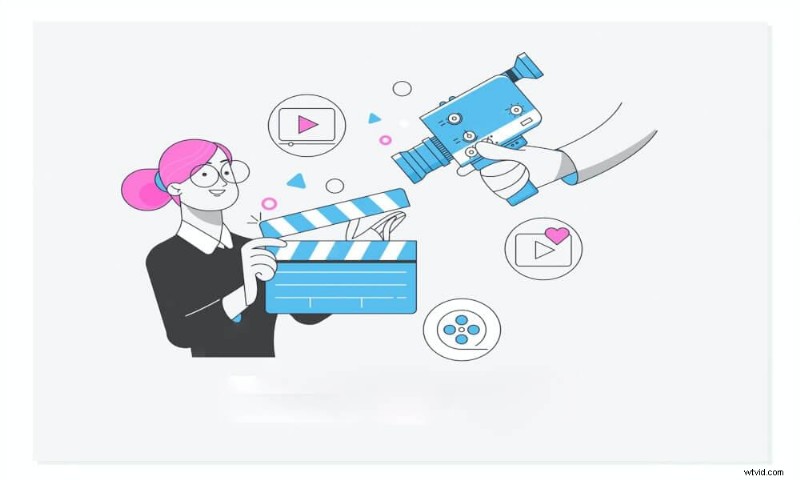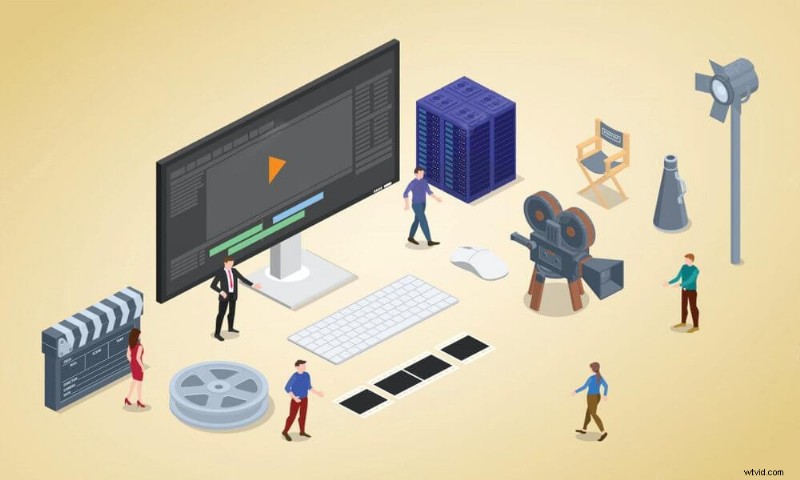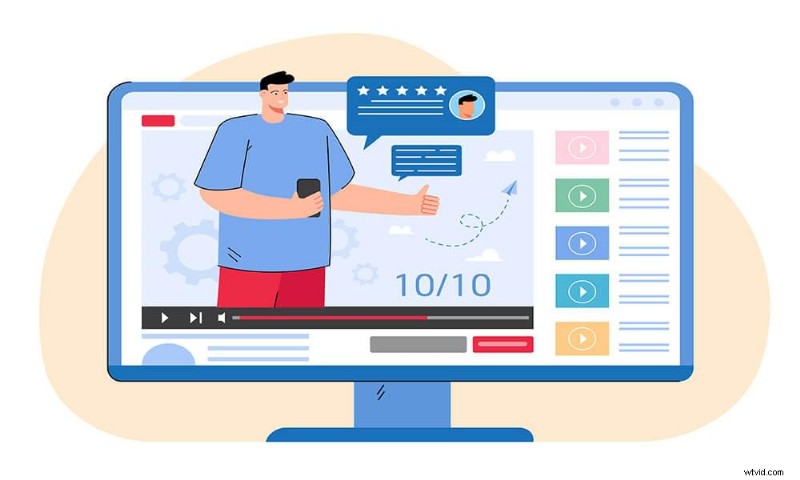I video didattici sono diventati parte integrante della strategia di marketing aziendale. Sono versatili e possono essere utilizzati per dimostrare prodotti, processi o servizi; assumere nuovi dipendenti; o informare i clienti.
La creazione di un video didattico non deve essere complicata o costosa. Infatti, con la giusta pianificazione ed esecuzione, puoi produrre un video dall'aspetto professionale con un budget ridotto.
Nel 2021, l'86% delle aziende ha affermato di aver avviato il video come strumento di marketing, mentre il 93% delle aziende ritiene che sia una parte fondamentale della propria strategia di marketing aziendale. Le aziende non sono più riluttanti o hanno un atteggiamento convenzionale nei confronti della domanda più evidente di contenuti video. Il modo in cui prospera in tutti i forum di marketing, non rimane più un fattore trascurabile.
Cisco ha riferito che entro il 2022 i contenuti video prospereranno su Internet, occupando l'82% del traffico online complessivo. Inoltre, la ricerca aziendale approfondisce l'interesse dei consumatori poiché l'84% degli acquirenti prende una decisione di acquisto finale dopo aver visto il video e le demo del prodotto e le revisioni tecniche basate su video. È doppiamente probabile che condividano dopo aver visto un buon video di recensione del prodotto.
Consigli rapidi:
- I video didattici sono emersi come un modo importante per le aziende di entrare in contatto con i consumatori .
- I video informativi sono una parte sempre più essenziale della SEO e della strategia di marketing digitale.
- Vlogging e storie di social media basate su video sono modi eccellenti per mostrare l'immagine del marchio e creare una connessione speciale con il tuo pubblico.
- La maggior parte del pubblico guarda video senza audio.
- I contenuti video generati dagli utenti sono noti come la forma più degna di contenuti online.
I video didattici sono il nuovo upsell.
Poiché sempre più aziende si rivolgono ai video per raggiungere il proprio pubblico, è importante sapere come creare un video che sia sia informativo che coinvolgente.
Cos'è un video didattico?
I video didattici sono disponibili in una varietà di forme diverse. Possono essere utilizzati per mostrare ai clienti come utilizzare il tuo prodotto oppure possono essere utilizzati come parte di un processo di inserimento dei dipendenti. I video didattici possono essere utilizzati anche per formare i dipendenti su nuovi processi o procedure.

Indipendentemente dalla forma che assumono, i video didattici dovrebbero essere chiari, concisi e facili da seguire.
Le aziende e le organizzazioni stanno manifestando la loro preferenza per l'utilizzo di video didattici e video di formazione come contenuti educativi per quasi tutti i settori. Ad esempio:
- Marketing :video dimostrativi dei prodotti o video promozionali incentrati sul settore
- eLearning :Corsi online
- Professionisti delle risorse umane :video di formazione dei dipendenti
I video didattici coinvolgenti devono essere semplici da seguire, visivamente dinamici e trasmettere un messaggio diretto alle esigenze del pubblico di destinazione.
Sebbene il contenuto dei video didattici varierà a seconda del pubblico di destinazione e del risultato desiderato, ci sono alcuni elementi chiave condivisi da tutti i video didattici di successo. In questo articolo, ti forniremo X suggerimenti per la creazione di video didattici che insegnino, informino e coinvolgano gli spettatori.
Come realizzare video didattici?
1. Definisci lo scopo del tuo video didattico:
Prima di iniziare a creare il tuo video didattico, è importante definire lo scopo del video. Chiediti cosa vuoi che lo spettatore impari o faccia dopo aver guardato il video. Questo ti aiuterà a determinare il contenuto, il tono e lo stile del video.
Ad esempio, se stai creando un video dimostrativo del prodotto, vorrai concentrarti sul mostrare come funziona il prodotto e quali vantaggi offre. Se invece stai creando un video didattico per i dipendenti, vorrai concentrarti sul fornire istruzioni chiare e concise su come completare un'attività.
Identifica i punti deboli e i requisiti degli utenti per lavorare su video didattici che offrono soluzioni agli spettatori. Devi sapere in quale regione si trova il tuo pubblico, la sua fascia di età, a quali contenuti sarebbero interessati e così via. I video didattici sono pianificati intorno a questi parametri dalle aziende.
Ricorda di stabilire obiettivi chiari per i tuoi video didattici.
I video didattici non sono una soluzione "taglia unica". Il contenuto, la durata e lo stile del tuo video variano a seconda dello scopo del video e delle esigenze del tuo pubblico.
Alcune aziende commettono l'errore di creare lunghi video didattici pieni di gergo tecnico e difficili da seguire. Altri creano video troppo brevi e privi dei dettagli necessari per essere veramente utili.
La chiave è trovare un equilibrio tra fornire informazioni sufficienti che riguardino i punti deboli degli utenti e rispondere a tutte le loro domande senza sopraffare lo spettatore.
Dopo aver determinato lo scopo del tuo video didattico, puoi passare al passaggio successivo:pianificare i contenuti.
2. Sii breve e dolce:
I video didattici dovrebbero essere brevi e pertinenti. Nessuno vuole guardare un video di 20 minuti quando può apprendere le stesse informazioni in 5 minuti. Mantieni i tuoi video didattici al di sotto dei 5 minuti quando possibile.
Se il tuo prodotto è complesso, valuta la possibilità di realizzare una serie di brevi video per alleviare il pubblico dal sovraccarico cognitivo.

3. Trova il tono giusto:
Il tono del tuo video didattico dovrebbe essere appropriato per l'argomento e il pubblico. Ad esempio, se stai creando un video di formazione sulla sicurezza, il tono dovrebbe essere serio. Se stai creando un video di marketing, tuttavia, il tono può essere più spensierato.
A seconda della nicchia della tua attività, puoi provare cose diverse per renderla più coinvolgente.
🚩 Animazione è uno dei modi più attraenti e interattivi per comunicare il tuo messaggio aziendale con i tuoi utenti attraverso i video. I video animati possono offrire alle aziende vantaggi multiuso come
✅ Sono un ottimo modo per spiegare un concetto o un messaggio aziendale in un breve lasso di tempo
✅ Sono facili da seguire e possono mantenere l'attenzione dell'utente per tutto il video
✅ Possono essere utilizzati anche per scopi di marketing per aumentare la consapevolezza del marchio e creare un'identità unica
✅ Sono anche un ottimo modo per aumentare il traffico del sito Web ed esprimere qualsiasi concetto astratto con immagini e metafore, purché disegnabili.
Ad esempio, Big Bang Science intrattiene i suoi spettatori mentre spiega argomenti scientifici fondamentali.
🚩 Video live-action mostra la vita come la vediamo noi. Mantenere i video il più naturali possibile è anche uno dei modi per mostrare ai tuoi spettatori il lato onesto e trasparente dei tuoi prodotti aziendali.
Inoltre, i video live-action sono perfetti per una comprensione facile e precisa di argomenti complessi. La spiegazione dettagliata con riprese dal vivo può aiutare l'utente a connettersi con il video a livello personale.
Crea anche un senso di fiducia e lealtà nei confronti del brand in quanto aiuta l'utente a vedere un lato empatico e riconoscibile dell'azienda.
Dal momento che tutto diventa pro-high-tech, modelli AR/VR , o simulazioni in alcuni casi, vengono spesso utilizzate per ottenere un risultato di alta qualità. La maggior parte delle aziende ha utilizzato video didattici dal vivo durante le pandemie e il blocco per tour o eventi virtuali.
Le simulazioni sono uno dei tipi di video didattici che possono essere utilizzati per un approccio più pratico senza alcun rischio reale. Viene utilizzato per guidare l'utente attraverso un processo o una situazione in modo che possa avere un'idea di come sarebbe nella vita reale.

Ad esempio, i team di vendita o i team per il successo dei clienti dell'azienda che gestisce il settore del mobile hanno iniziato a ospitare tour ed eventi virtuali per mostrare gli ultimi prodotti. Aiuta i clienti a prendere una decisione informata senza visitare effettivamente il luogo.
Questo è solo un riassunto di cosa sono i video didattici e di come puoi usarli per la tua attività. Inoltre, i video didattici possono diventare più accessibili e migliorare l'esperienza dell'utente se aggiungi didascalie e sottotitoli.
L'aggiunta di didascalie e sottotitoli ai tuoi video didattici è un ottimo modo per renderli più accessibili e migliorare l'esperienza dell'utente. Aiuta anche gli spettatori che non sono madrelingua inglese a comprendere meglio il video.
I sottotitoli possono anche aiutare gli spettatori con problemi di udito o che parlano una lingua diversa a comprendere il video. Puoi facilmente aggiungere sottotitoli e traduzioni ai tuoi video didattici facendoli scorrere attraverso uno strumento di generazione di sottotitoli.
Puoi aggiungere traduzioni di oltre 100 lingue diverse con la garanzia di una precisione del 99%. Rendere i contenuti video accessibili a un pubblico globale è diventato più facile che mai con l'aiuto dei generatori di sottotitoli automatici basati sull'intelligenza artificiale.

🚩 Uno screencast , o la registrazione digitale tramite dispositivi intelligenti o lo schermo di un computer, è un modo semplice per mostrare come utilizzare un'app tecnica o un prodotto software. I video screencast sono un modo semplice per descrivere come integrare i prodotti con altri prodotti..
4. Scegli saggiamente la tua piattaforma:
Esistono diverse piattaforme che puoi utilizzare per ospitare i tuoi video didattici. Ti consigliamo di scegliere una piattaforma facile da usare e che fornisca le funzionalità di cui hai bisogno. Ad esempio, se desideri che gli spettatori possano interagire con il video, ti consigliamo di scegliere una piattaforma che supporti le annotazioni video.
Alcune delle piattaforme più popolari per i video didattici sono YouTube, Vimeo e Wistia. I professionisti delle risorse umane e dell'eLearning molto probabilmente preferiranno un sistema di gestione dell'apprendimento più sicuro e personalizzabile come alternativa e ci sono molte piattaforme online tra cui scegliere.
Quando decidi su una piattaforma di hosting video per i tuoi video didattici e di formazione, dovresti considerare i seguenti fattori:
- Facilità d'uso: La piattaforma dovrebbe essere facile da usare in modo da poter creare e pubblicare video rapidamente.
- Qualità video: La piattaforma dovrebbe supportare video di alta qualità in modo che i tuoi video abbiano un aspetto professionale.
- Interattività: La piattaforma dovrebbe supportare funzionalità che consentano agli spettatori di interagire con il video, come le annotazioni video.
- Analisi: La piattaforma dovrebbe fornire analisi in modo da poter tenere traccia di chi sta guardando i tuoi video e di come interagisce con essi.
- Prezzi: La piattaforma dovrebbe essere conveniente in modo da poter creare e pubblicare video senza spendere una fortuna.
5. Investi in una produzione di qualità:
I video didattici devono essere di alta qualità e dall'aspetto professionale. Questo non significa che devi assumere una società di produzione, ma significa investire in alcune attrezzature di base, come un buon microfono e illuminazione.

Pianificare i tuoi video di formazione aziendale è un modo realistico per conoscere le tue risorse per il progetto. Meet with senior leadership to specify a suitable video budget.
Video content is on the rise, and it’s no surprise why. AI-powered tools are making it easier and more affordable to create professional quality videos without any painstaking work. The video making process goes something like this:
A. Plan your video script
B. Shoot your video through a smartphone, DSLR, or communication software such as Zoom.
C. Run through AI-based caption and subtitle generating software. It will help remove all diction, grammatical and language errors. Such softwares usually have an editing dashboard to help you remove any errors in subtitles or to even stylise the text.
D. Add your preferred translations through the same subtitle generating tool.
E. Add most synthetic human-like voices in your preferred accent and any language through AI-based speech-to-text tools—saving your cost for a paid voice actor.
F. This is where the magic happens! After some basic video editing and subtitling including animations, graphics or even pictures - your finished product will be able to thrive across all platforms.
With the help of AI-based tools, it not just automates the recurring tasks; it saves human efforts, time, and money.
6. Your instructional videos script - step by step learning
No matter what type of instructional video you’re creating, it’s important to have a well-written script that clearly shows a step by step learning process. A good script will ensure that your video is clear, concise, and easy to understand.
When writing the script for your instructional video, there are a few things to keep in mind:
- A. Keep it short and sweet:The shorter the better. instructional videos should be concise and to the point.
- B. Use simple language:Use language that is easy to understand. Avoid jargon and technical terms.
- C. Write in the second person:Address the viewer directly by using “you” throughout the script.
A good script will make it easy for you to create a clear and concise video that is easy to understand. So take the time to write a good script, and your instructional videos will be all the better for it.
After brainstorming your video’s outlines, it’s time to arrange your thoughts in a logical order by writing a script. This will help ensure your video is clear, concise, and easy to understand.

Try the following hacks to write a simple, objective-oriented, and engaging video script.
- Tell a captivating story .
Begin with telling a simple story of your business in a way that could relate to the lives of the audience. When presented with a long-drawn list of boring facts and figures, audiences may lose focus.
You can start by telling the solutions to the problems your audience is looking for. You can hook the audience successfully for the first 30 seconds(which are critical for the viewer’s mind making decision).
Later, you can explain the solutions in a few details and add a few lines on your brand to let them know about your business. By watching the video, they may not buy your product but your business name will be stored somewhere in their subconsciousness, and perhaps they would like to recommend your products to their close circle.
- Never forget to add compelling yet meaningful images.
Video is mainly a visual medium, so be conscious of how you can add special meaning to your videos by adding graphic images. - Add imagery and narration over subtitles
Reduce cognitive load by adding compelling imagery, narration, and subtitles to enhance your audience’s visual experience. - Consider branched scenario S
Business development and strategists often choose to create instructional videos with different scenario branches, a form of learning similar to a “choose your way of watching the video”.
If you’re making a video with multiple learning paths, write different scripts for each scenario to avoid confusion. - Make ‘em laugh
An instructional or training video doesn’t have to be entirely serious. Your viewers will relish a few puns and jokes to get a little break from the hard-core video.
The instructional videos include a few subtle jokes to make the targeted viewers smile. - Ask for input
Get the script reviewed by experts to ensure that your video meets its informational objective. They will confirm the accuracy of the technical information. Once you’ve formed a script for your instructional or training video, you’re prepared to transform those ideas into visuals.
7. Storyboarding your instructional video
Storyboarding is the procedure of visual curation of product information. 2C marketers use it to map out the buyer’s journey while B2B instructional designers use it to ensure learning objectives are met.
By looking at each frame, you can analyze your video’s quality and accuracy of visuals and decide which imagery is serving your business objective.

- Don’t worry about artistic ability
It’s okay if you only know how to draw stick figures. As long as you can communicate the main actions in every frame, your storyboard will be useful. - Storyboard alongside your script
Make the progression of your instructional video clear by including your script in a column next to your storyboard drawings. If a viewer gets lost, they can refer to the dialogue and descriptions in your script column to understand everything happening at that moment. - Signal where the video is going next
Viewers are more likely to focus on your instructional video if they have a sense of what is coming next. To make your instructional and trainings video easy to follow, include visual cues in your storyboard, such as character expressions and actions or header text. - Organize your frames with templates
If you prefer to hand-draw your storyboard, you don’t need to draw boxes for every frame—use this free template. The printed boxes will save you time and give your storyboard an organized, uniform look. - Speed up creation with animation software
Don’t want to hand-draw your storyboard? Use animation software, like Vyond, to create your storyboard. You’ll be able to quickly create each frame with drag-and-drop scenery, props, and characters. If you’re planning to use animation for the project, you’ll be able to create your video from these storyboard frames in a short amount of time when production begins.
8. Creating your instructional video
The production phase can feel frantic at times, even if you’ve prepared well for it. Equipment may need unexpected troubleshooting, or you may discover that you can’t film a shot as you imagined in your storyboard.
To help you stay on track, here are a few suggestions for crafting an engaging and informative video that you may have overlooked.

- Minimize cognitive load
Viewers can process only so much information at a time. To avoid cognitive overload, limit the amount of sensory content you present at one time. For example, don’t present dense information through narration at the same time as an energetic music cue. - Invest in professional voiceover
If your video includes dialogue or narration, consider investing in a professional voiceover. A trained actor is acan vocal emphasis to express ideas, so their voiceover will make the content more understandable for viewers. To hire a voiceover artist, consider using popular speech-to-text tools. - Add interactivity
Interactive videos allow viewers to click, drag, hover, and complete other digital actions to interact with video content rather than just playing it.
This example from Ana Grade, a senior instructional designer at Amazon, includes an interactive skill check at the end.
Adding these features boosts engagement by forcing audiences to stop and demonstrate their knowledge. While marketing and HR professionals might not create interactive videos, eLearning professionals use complex authoring programs, like Storyline, that allow quizzes and other interactive elements to be inserted into instructional videos. Ana used Vyond and Storyline 3 to create the training video above.
If you have trouble playing the interactive example, try switching browsers or updating Chrome.
10. Promote, promote, promote!:
Once your instructional video is complete, it’s important to promote it. You can promote your instructional video on your website, email, or social media marketing. Use these tips to help promote and market your videos:

- Ensure that your video is device-friendly
Make it possible for people to watch your instructional video in any learning environment by optimizing your video for all devices. Giving people this ability increases the likelihood that they will easily access and complete watching your video. - Set up an engaging thumbnail
Encourage views by picking a clear, compelling image that reflects the topic of your video for its thumbnail. When a person is deciding whether they want to watch a video, they look at its thumbnail, or resting snapshot. - Marketing:Share on niche social media chann els
If you’re a marketer hoping to attract leads with your instructional video, consider using niche social media platforms to promote the content. For example, you might share a link to the video on a relevant subreddit or an industry-specific online forum. These spaces are crowded with high-quality leads who are at times genuinely interested in your product or services. - HR:Incorporate your video into on-boarding
If your instructional video is relevant to employee training for new hires, work with your HR team to incorporate the content into your on-boarding plan. By scheduling the video in the on-boarding timeline, you ensure that new employees will watch the video and build the knowledge they need to succeed in your workplace. - eLearning:categorize your video
Online course websites, such as Lynda, typically present their most recent and most popular courses on their homepage. If you’ve just created a set of instructional videos, work with your site developers and administrators to see if the course can be featured on your homepage to promote views.
11. Get feedback and iterate:
Finally, don’t forget to get feedback on your instructional video from both viewers and experts. Use this feedback to improve the quality of future instructional videos you create.

Creating a captivating educational video requires big-picture thinking. You’re trying to inform and engage viewers at the same time, so you must be aware of multiple factors at once:your learning objective, technical constraints, distribution tactics, and more.
Instead of trying to remember every area, return to this post, and follow these detailed tips every time you make an instructional video. If you’re able to check off every tip, you can rest well knowing that you’ve taken steps to make your video engaging for your target audience.
